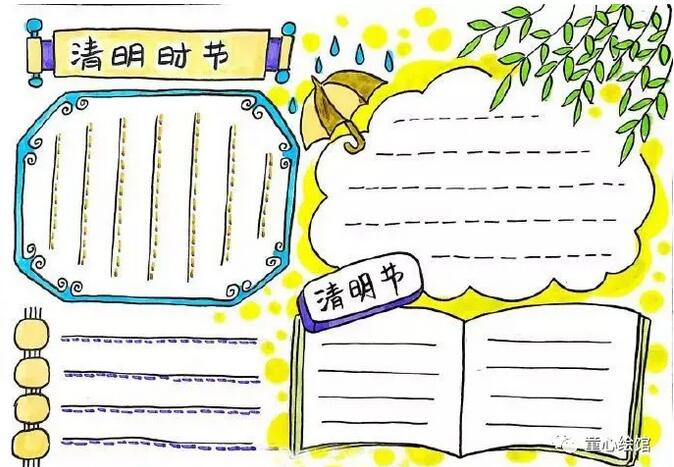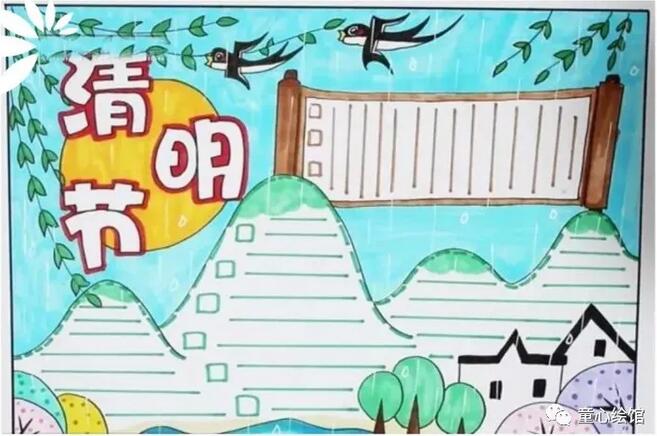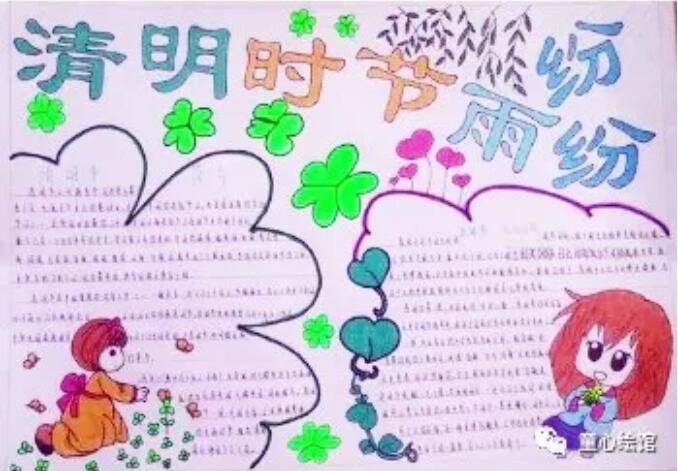[手抄报]首先画人民英雄纪念碑框架。写上人民英雄永垂不朽,完善一下细节。画一个敬礼的少先队员,在纪念碑后面画上国旗和五角星。画一些大大小小的蜡烛。画一些松树等背景,完善下细节。最
















05
清明节手抄报
中文填写内容
一、清明节的简介:
清明节是中国重要的“时年八节”之一,一般是在公历4月5号前后,节期很长,有10日前8日后及10日前10日后两种说法,这近20天内均属清明节。清明节原是指春分后十五天,1935年中华民国政府明定4月5日为国定假日清明节,也叫做民族扫墓节。
《历书》:“春分后十五日,斗指丁,为清明,时万物皆洁齐而清明,盖时当气清景明,万物皆显,因此得名。”清明一到,气温升高,正是春耕的大好时节,故有“清明前后,种瓜点豆”之说。
清明节的起源,据传始于古代帝王将相“墓祭”之礼,后来民间亦相仿效,于此日祭祖扫墓,历代沿袭而成为中华民族一种固定的风俗。2006年5月20日,中国文化部申报的清明节经国务院批准列入第一批国家级非物质文化遗产名录(类别:民俗;编号:Ⅹ-2)。
二、传统习俗
清明节的习俗除了讲究禁火、扫墓,还有踏青、荡秋千、蹴鞠、打马球、插柳等一系列风俗体育活动。相传这是因为寒食节要寒食禁火,为了防止寒食冷餐伤身,所以大家来参加一些体育活动,来锻炼身体。清明节,民间忌使针,忌洗衣,大部分地区妇女忌行路。傍晚以前,要在大门前洒一条灰线,据说可以阻止鬼魂进宅。因此,这个节日中既有祭扫新坟生离死别的悲酸泪,又有踏青游玩的欢笑声,是一个富有特色的节日。
三、祭祀扫墓
清明节是中国三大鬼节之一。“鬼节”即是悼念亡人之节,是和祭祀天神、地神的节日相对而言的。
清明祭祀的参与者是全体国民,上至君王大臣,下至平头百姓,都要在这一节日祭拜先人亡魂。从唐朝开始,朝廷就给官员放假以便于归乡扫墓。据宋《梦粱录》记载:每到清明节,“官员士庶俱出郊省墓,以尽思时之敬。”参加扫墓者也不限男女和人数,往往倾家出动。这样清明前后的扫墓活动常成为社会全体亲身参与的事,数日内郊野间人群往来不绝,规模极盛。
四、清明节节日谚语
◇ 雨打清明前,春雨定频繁(鲁)
◇ 阴雨下了清明节,断断续续三个月(桂)
◇ 清明难得晴,谷雨难得阴(鲁)
◇ 清明不怕晴,谷雨不怕雨(黑)
◇ 雨打清明前,洼地好种田(黑)
◇ 清明雨星星,一棵高粱打一升(黑)
◇ 清明宜晴,谷雨宜雨(赣)
◇ 清明断雪,谷雨断霜(华东、华中、华南、四川及云贵高原)
◇ 清明断雪不断雪,谷雨断霜不断霜(冀、晋)
◇ 清明无雨旱黄梅,清明有雨水黄梅(苏、鄂)
五、关于清明节的古诗
清明
【唐】杜牧
清明时节雨纷纷,
路上行人欲断魂。
借问酒家何处有?
牧童遥指杏花村。
途中寒食
(唐)宋之问
马上逢寒食,途中属暮春。
可怜江浦望,不见洛桥人。
北极怀明主,南溟作逐臣。
故园肠断处,日夜柳条新。
《寒食》
(唐)韩翃
春城无处不飞花,寒食东风御柳斜。
日暮汉宫传蜡烛,轻烟散入五侯家。
《闾门即事》
(唐)张继
耕夫召募爱楼船,春草青青万项田;
试上吴门窥郡郭,清明几处有新烟。
《清明》
(宋)王禹俏
无花无酒过清明,兴味萧然似野僧。
昨日邻家乞新火,晓窗分与读书。
《苏堤清明即事》
(宋)吴惟信
梨花风起正清明,游子寻春半出城。
日暮笙歌收拾去,万株杨柳属流莺。
《寒食上冢》
(宋)杨万里
迳直夫何细!桥危可免扶?
远山枫外淡,破屋麦边孤。
宿草春风又,新阡去岁无。
梨花自寒食,进节只愁余。
《清明日曲江怀友》
【唐】罗隐
君与田苏即旧游,我于交分亦绸缪。
二年隔绝黄泉下,尽日悲凉曲水头。
鸥鸟似能齐物理,杏花疑欲伴人愁。
寡妻稚子应寒食,遥望江陵一泪流。
清明即事
【唐】孟浩然
帝里重清明,人心自愁思。
车声上路合,柳色东城翠。
花落草齐生,莺飞蝶双戏。
空堂坐相忆,酌茗聊代醉。
送陈秀才还沙上省墓
【宋】高启
满衣血泪与尘埃,乱后还乡亦可哀。
风雨梨花寒食过,几家坟上子孙来?
清江引·清明日出游
【明】王磐
问西楼禁烟何处好?
绿野晴天道。
马穿杨柳嘶,
人倚秋千笑,
探莺花总教春醉倒。
清明夜
【唐】白居易
好风胧月清明夜,碧砌红轩刺史家。
独绕回廊行复歇,遥听弦管暗看花。
06
清明节手抄报
中英文对照内容
“清明”英文怎么讲
作为中国人,对于这些从小看大的习俗我们当然不会陌生,可如果问你“清明”用英文怎么讲、你就未必知道了吧!
首先我们要清楚的是:作为节日的清明节、和作为节气的清明节,它们的英文说法是不同的。
作为节日的清明节一般翻译为"Tomb Sweeping festival"或者"Tomb-sweeping Day",扫墓节或扫墓日。这个翻译着重强调了清明节的重要习俗“扫墓”。这种说法的好处是,老外一听就能大概明白这个节日的背后含义。
也有人把清明节翻译为"All Souls'Day",这是一种站在对方文化角度考虑做出的翻译。因为"All Souls'Day"在西方是确实存在的节日,一般称为“万灵日”。这是一个宗教节日,在有的教派里甚至不止一天。教会会在这一天为那些去世后无法进入天堂的信徒祈祷,希望他们早日进入天堂。其基本意义和清明节相似,也是祭奠死者的节日。
另外再谈到作为节气的清明,它被译为"Clear and Bright",清洁和明亮。我们也不难发现,这种译法强调的是清明时节的气候状况,和其他节气的翻译出发点一致。比如立夏被译为"Summer begins"、小寒、大寒分别被译为"Slight cold"和"Great cold"。
有关清明节的起源
ORIGIN(起源)
Qing Ming is popularly associated with Jie Zi Tui, who lived in Shanxi province in 600 B.C. Legend has it that Jie saved his starving lord's life by serving a piece of his own leg. When the lord succeeded in becoming the ruler of a small principality, he invited his faithful follower to join him. However, Jie declined his invitation, preferring to lead a hermit's life with his mother in the mountains.
谈到清明节,有点历史知识的人,都会联想到历史人物介子推。据历史记载,在两千多年以前的春秋时代,晋国公子重耳逃亡在外,生活艰苦,跟随他的介子推不惜从自己的腿上割下一块肉让他充饥。后来,重耳回到晋国,作了国君(即晋文公,春秋五霸之一),大事封赏所有跟随他流亡在外的随从,惟独介子推拒绝接受封赏,他带了母亲隐居绵山。
Believing that he could force Jie out by burning the mountain, the lord ordered his men to set the forest on fire. To his consternation, Jie chose to remain where he was and was burnt to death. To commemorate Jie, the lord ordered all fires in every home to be put out on the anniversary of Jie's death. Thus began the "cold food feast", a day when no food could be cooked since no fire could be lit.
晋文公无计可施,只好放火烧山,他想,介子推孝顺母亲,一定会带着老母出来。谁知这场大火却把介子椎母子烧死了。为了纪念介子推,晋文公下令每年的这一天,禁止生火,家家户户只能吃生冷的食物,这就是寒食节的来源。
The "cold food" festival occurs on the eve of Qing Ming and is often considered as part of the Qing Ming festival. As time passes, the Qing Ming festival replaced the "cold food" festival. Whatever practice is observed,the basic observation of Qing Ming is to remember one's elders by making a special effort to visit their graves, ashes or ancestral tablets. To make the visit even more meaningful, some time should be spent to remind the younger members of the family of the lives and contributions of their ancestors, and the story of Jie Zi Zhui who choose death over capitulation.
寒食节是在清明节的前一天,古人常把寒食节的活动延续到清明,久而久之,清明取代了寒食节。拜介子推的习俗也变成了清明扫墓的习俗了。无论以何种形式纪念,为了使纪念祖先的仪式更有意义,我们应该让年轻一代的家庭成员了解先人过去的奋斗历史,当然,还要学习介子推宁死不屈的气节。
清明节习俗
清明节是一个特殊的日子,在这一天生者为他们死去的亲朋献上敬意。(Tomb-Sweeping Day falls on April 4th or 5th. This is a special day for the living to show their love and respect for dead friends and relatives.)每逢清明时节,中国人会去扫墓祭祖,在祖先坟前献上祭品、鲜花,烧些纸钱。有的人还会写悼文,缅怀逝去的亲人。
说到“纸钱”,英语中是怎么表述的呢?大家可能第一时间想到的就是paper money。不过字面上它是“纸钱”的意思,实际上paper money的意思是“纸质货币”,与metal money(金属货币)相对应,不是烧给死者的纸钱噢!那么,烧给死者的“纸钱”怎么表达呢?可以用joss paper或hell bank notes表示。
除了传统的祭祀方式,近年来,“绿色祭扫”逐渐成为人们扫墓的一种新趋势。不仅经济环保,还避免了烧纸钱等传统方式带来的火灾隐患。“绿色祭扫”的方式有很多,如网上祭扫(online tomb-sweeping)和网络纪念馆(Internet memorial)等。
扫墓 grave
At the Qingming Festival (Tomb-Sweeping Day), people usually worship their ancestors by burning incense and paper money at their ancestors' grave sites. People show respect to their ancestors by visiting their graves, and offering food, wine, flower, etc. They sweep the tombs, removing weeds, and adding fresh soil to the graves, stick willow branches on the tomb, and burn paper money. They pray before their ancestors' graves and beseech them to bless their families. However, the custom has been greatly simplified today, especially in cities, where only flowers are presented to the dead.
清明节,人们通常在祖宗坟前焚香烧纸,拜祭祖先。人们来到祖先坟前,供上食物、酒水、鲜花等,以示敬意。他们扫墓、除草、添土,在墓上插柳并焚烧纸钱。他们在祖先坟前祷告,请求他们保佑家人。但是,如今的习俗已大大简化,特别是在城里,他们只向逝者献花。
荡秋天 On the Swings
这是中国古代清明节习俗。秋千,意即揪着皮绳而迁移。它的历史很古老,最早叫千秋,后为了避忌讳,改之为秋千。古时的秋千多用树桠枝为架,再栓上彩带做成。后来逐步发展为用两根绳索加上踏板的秋千。荡秋千不仅可以增进健康,而且可以培养勇敢精神,至今为人们特别是儿童所喜爱。
This is the qingming festival custom in ancient China. Swing, ie, ripping up the leather rope and migration. Its history is very old, the first call and consent, in order to avoid taboo, after change it as a swing. Ancient tree swing multi-purpose YaZhi for frame, bolt ribbons made again. Then gradually developed to use two rope and a pedal swing. Swing can not only improve health, but also can cultivate the spirit of brave, for people, especially children's favorite.
荡秋千不仅可以增进健康,而且可以培养勇敢精神,至今为人们特别是儿童所喜爱。
Play not only improves the health swing, and can cultivate the brave spirit, tonow is people, especially children's favorite.
Gamecalled cuju 蹴鞠
A ball is bowed, ball with leather skinmade, the ball inside with wool plugged. A game called cuju, which is withenough to play football. This is ancient tomb-sweeping day's favorite when a game.Legend has it that the invention of the yellow emperor, original purpose isused to train warrior.
鞠是一种皮球,球皮用皮革做成,球内用毛塞紧。蹴鞠,就是用足去踢球。这是古代清明节时人们喜爱的一种游戏。相传是黄帝发明的,最初目的是用来训练武士。
鞠是一种皮球,球皮用皮革做成,球内用毛塞紧。蹴鞠,就是用足去踢球。
A ball is bowed, ball with leather skinmade, the ball inside with wool plugged. A game called cuju, which is withenough to play football.
插柳 Insert willow
据说,插柳的风俗,也是为了纪念“教民稼穑”的农事祖师神农氏的。有的地方,人们把柳枝插在屋檐下,以预报天气。清明节谚有“柳条青,雨蒙蒙;柳条干,晴了天”的说法。黄巢起义时规定,以“清明为期,戴柳为号”。起义失败后,戴柳的习俗渐被淘汰,只有插柳盛行不衰。杨柳有强大的生命力,俗话说:“有心栽花花不发,无心插柳柳成荫。”柳条插土就活,插到哪里,活到哪里,年年插柳,处处成阴。
It is said that the work of the customs, is to commemorate the "leisure farm" of farming father of the emperor shen nung. In some places, people placed willow branches under the eaves, to predict the weather. Tomb-sweeping day is the "willow green, rain receive; the wicker dry, sunny days". Huang Chao uprising rules, to "for the tomb-sweeping day, Dai Liu to date". After a failed uprising, the custom of Dai Liu gradually be eliminated, only liu fixture. Willow has strong vitality, as the saying goes: "many hair, accidentally a remarkable." Wicker soil lived, where, where to live, year after year, colorful everywhere.
清明插柳戴柳还有一种说法:原来中国人以清明、七月半和十月朔为三大鬼节,是百鬼出没讨索之时。人们为防止鬼的侵扰迫害,而插柳戴柳。柳在人们的心目中有辟邪的功用。受佛教的影响,人们认为柳可以却鬼,而称之为“鬼怖木”,观世音以柳枝沾水济度众生。北魏贾思勰《齐民要术》里说:“取柳枝著户上,百鬼不入家。”清明既是鬼节,值此柳条发芽时节,人们自然纷纷插柳戴柳以辟邪了。
Qingming festival work Dai Liu has a saying: the original Chinese to the tomb-sweeping day, half July and October back to three Halloween, beg suo is haunted by a ghost. People in order to prevent the intrusion of ghost persecuted, and willow Dai Liu. Willow has the function of to ward off bad luck in people's mind. Influenced by Buddhism, willow were thought to ghost, and call it "ghost some wood", the goddess of mercy to switch touch water to degrees of living beings. In the northern wei jia sixie qimin yaoshu said: "take willow branches on the door, a ghost does not enter the house." On the occasion of the willow germination time, the tomb-sweeping day is Halloween, people naturally have inserted liu Dai Liu to ward off bad luck.
蚕花会 Silkworm flower show
“蚕花会”是蚕乡一种特有的民俗文化,过去清明节期间,梧桐、乌镇、崇福、洲泉等地都有此项民俗活动。其中以洲泉的马鸣庙和青石的双庙诸的蚕花会最为精彩隆重。马鸣庙位于洲泉镇西,在当地有“庙中之王”之称,每年蚕花会人山人海,活动频繁,有迎蚕神、摇快船、闹台阁、拜香凳、打拳、龙灯、翘高竿、唱戏文等十多项活动。这些活动有的在岸上进行,绝大多数在船上进行,极具水乡特色。近几年乌镇香市活动中的蚕花会,仅有迎蚕神、踏白船、翘高竿等几个项目,大有潜力可挖。
Silkworm flower show "silkworm flower show" is a kind of unique folk culture of silkworm township, in the past during the qingming festival, wutong springs, wuzhen, chung fu, state and other places have the folk activities. In which continent springs Ma Ming temple and bluestone ShuangMiao the silkworm flower is the most wonderful grand. Springs west Ma Ming temple is located in the state, in the local has the "king of the house," said, silkworm flower people mountain people sea, every year, one to meet silkworm god, shaking the clippers, eventually leaves, worship the stool, boxing, dragon lantern, become warped high pole, singing opera and so on more than ten activities. Some of these activities on shore, the vast majority of on board ship, water features extremely. Silkworm flower wuzhen incense city activities in recent years, only to meet silkworm god, stepping white ship, become warped a few projects such as the high pole, great potential.
牵钩 Pull hook
牵钩”是古称,其实就是现代的拔河运动。据说春秋时,楚国为了进攻吴国,以牵钩这种运动来增强人民的体质。它主要是以一根麻绳,两头分为许多小绳,比赛时,以一面大旗为界,一声令下,双方各自用力拉绳,鼓乐齐鸣,双方助威吶喊,热闹非常。
"Pull hook" is called, in fact, the modern tug-of-war sport. It is said that in the spring and autumn, in order to attack chu wu to hook the movement to improve people's physical fitness. It is primarily a rope, two head is pided into many small line, game, with a banner for the world, commanded, each pull rope, the music is, everywhere cheer both sides up, a lively group.
耳熟能详的清明诗
清明
杜牧
清明时节雨纷纷,
路上行人欲断魂。
借问酒家何处有?
牧童遥指杏花村。
这首杜牧《清明》各种英文翻译版本也有很多:
1、许渊冲译
A drizzling rain falls like tears on the Mourning Day
The mourner's heart is going to break on his way。
Where can a wineshop be found to drown his sad hours?
A cowherd points to a cot 'mid apricot flowers。
2、吴伟雄译
It drizzles thick and fast on the Mourning Day,
The mourner travels with his heart lost in dismay.
When asked for a wineshop to kill his gloomy time,
A cowboy points at Almond Hamlet far away
3、万昌盛、王僴中译
The ceaseless drizzle drips all the dismal day,
So broken-hearted fares the traveler on the way.
When asked where could be found at avern bower,
Acow boy points to yonder village of the apricot flower.
4、杨宪益、戴乃迭译
It drizzles endless during the rainy season in spring,
Travelers along the road look gloomy and miserable。
When I ask a shepherd boy where I can find a tavern,
He points at a distant hamlet nestling amidst apricot blossoms。
5、吴钧陶译
It drizzles thick and fast on the Pure Brightness Day,
I travel with my heart lost in dismay。
"Is there a public house somewhere, cowboy?"
He points at Apricot Village faraway。
6、蔡廷干译
The rain falls thick and fast on All Souls' Day,
The men and women sadly move along the way。
They ask where wineshops can be found or where to rest ----
And there the herdboy's fingers Almond-Town suggest。
7、孙大雨译
Upon theClear-and-Bright Feast of spring, the rain drizzleth down in spray。
Pedestrians on countryside ways, in gloom are pinning away。
When asked "Where a tavern fair for rest, is hereabouts to befound",
The shepherd boy the Apricot Bloom Vill, doth point to afar and say。
清明节美食
清明果
形状有些像饺子,但味却截然不同。清明果的皮是一种叫艾的植物做成的,将艾叶捣烂与米粉搅伴在一起,做成碧绿色的面团,鲜嫩欲滴。
Qingming fruit (or Qingming guo). It looks like dumplings in shape, but tastes different from dumplings. The wrapper of Qingming fruit is made from squeezed wormwood, rice and glutinous rice.
馓子
我国南北各地清明节有吃馓子的食俗。“馓子”为一油炸食品,香脆精美,古时叫“寒具”。
Eating Sanzi (or deep-fried dough twist)on Qingming Festival is a convention throughout China. Sanzi is a kind of fried food. People called it cold food in the old days.
清明螺
Spiral Shell 清明螺
清明时节,正是采食螺蛳的最佳时令,因这个时节螺蛳还未繁殖,最为丰满、肥美。
The Qingming Festival is the right time for eating spiral shell. Spiral shell is abundant in this season.
荠菜
Shepherd's-purse 荠菜
辛弃疾写道:“城中桃李愁风雨,春在溪头荠菜花。”
荠菜馄饨:Shepherd's Purse Wonton
荠菜黄鱼羹:Shepherd's Purse and Croaker
荠菜豆腐羹:Shepherd's Purse with beancurd
春笋
Bamboo Shoots in Spring 春笋
三月细雨绵绵,正是春笋的好时节。春笋贵在鲜,贵在清新淋漓。南方最常见的做法是“腌笃鲜”,咸肉、火腿、春笋在一起煮,既是汤,又是一道菜。
煨春笋:Bamboo Shoots Soup
清明节相关英文词汇
day of sacrifice 祭祀节日
offer sacrifices to ancestors 祭祖/上供
condolence 哀悼之情
hell note/joss paper 纸钱
funeral supplies/products 殡葬用品
funeral services 殡葬服务业
mortician 殡仪业者
burn incense 焚香
tomb-sweeping 扫墓
tomb sweeper 扫墓的人
kite flying 放风筝
spring outing 踏青
god's lantern 神灯
memorial tablet 纪念碑
willow branches inserted on each gate 门旁插柳
cremation urn 骨灰盒
mourning ceremony 哀悼仪式
inhumation 土葬
cremation 火葬
sea-burial 海葬
boat-coffin burial 船棺葬
tree burial 树葬
celestial burial 天葬
flower burials 花葬
filial piety 孝顺 孝心
Day of the Dead(亡灵节,墨西哥传统节日,人们通过守灵、上供等方式祭奠逝去的亲人。)
清明节英文例句
Why must we go and sweep the tomb on Tomb Sweeping Day?
为什么我们在清明节要扫墓啊?
In early April, we went to sweep the martyrs' graves.
清明节的时候,我们去为忠烈扫墓。
Do you have holidays on Tomb Sweeping Festival?
你清明节有放假吗?
Tomb-sweeping day is an important day for chinese.
清明节对中国人来说是一个很重要日子。
Write the tomb-sweeping day special atmosphere.
写出了清明节的特殊气氛。
We have three days free on Tomb-sweeping Day.
清明节我们放假三天。
The Qingming Festival is a statutory public holiday in mainland China.
清明节在中国大陆地区是法定节假日。
Over time, Hanshi Day was replaced with tomb-sweeping day.
随着时间的推移,寒食也为清明节所替代。
It reopened to former residents during Qingming, or tomb-sweeping day, in April.
四月份的清明节期间,对原该县百姓开放。
In this Tomb Sweeping Day for memorizing the deceased, people nevertheless sensed more of the power of life and showed great concern to their compatriots and great compliment to our state’s rescue.
在这个追思逝者的清明节,人们却更多地感受到了生命的力量、生命的顽强,他们表达着来自同胞的关爱与对国家救援的赞赏。
The Qingming Festival in spring is the occasion for visiting ancestral graves.
清明节是扫墓拜祭先人的日子。
According to our traditions and customs, flying kites usually happen at the QingMing Festival.
据中国传统习俗,人们通常在清明节放风筝。
Folk customs like climbing a mountain during the Double Ninth Festival orcleaning the tombs during the Qingming Festival deserve to be remembered asthey are integral part of the Chinese heritage.
重阳节登山和清明节扫墓等民俗应当被铭记,因为它们是中国文化遗产不可或缺的组成部分。
Qing Ming is a time to remember the dead and the dearly departed.
清明节是一个纪念祖先的节日。
How do people celebrate Qingming Featival?
人们在清明节会怎样过?
As millions paused to honor their ancestors during the annual Tomb-Sweeping Festival, the increasing cost of cemetery plots and funerals has become a focusof national anger.
随着中国人在一年一度的清明节期间祭祀先人,公墓及殡葬服务价格暴涨成为激起民愤的一个焦点问题。
Monday was China's traditional "Tomb-Sweeping Day", when people mourn theirdead.
周一是中国传统的清明节,人们在这一天祭奠逝去的亡灵。
Qingming Day, the traditional tomb-sweeping day, falls on April 4-6 each year.
每年4月4-6日左右的清明节是传统的扫墓的日子。
People around China commemorated deceased relatives and friends as theQingming Festival begins.
随着清明节的到来,全国各地的人们都在怀念和哀悼逝去的亲友
[手抄报]首先在左上角画两个长方形框,里面写上清明两个字。右下角画一个门形状的文本框。左下方画一个正方形文本框,在上方再画一条长线。上方画小船站着一个人,拱桥等。画远处的山,垂柳
[手抄报]首先在右下方画一些草丛。左下方画一些石头。画一个小亭子。石头旁边画一个乘着小船的小孩。画一些荷叶装饰。画上远处的山,再画一些柳树枝,写上清明两个字。最后涂上漂亮的颜色,
[手抄报]首先画一个简单的小亭子框架。完善好这个小亭子。上面画一些小房子,用柳条和下面的小亭子连起来。右面画一个画卷文本框,上面画一个小孩露出半个头。完善一下背景,画柳条、太阳等
[手抄报]首先画小孩的头部,头发和耳朵。画小孩的五官,后面带个帽子,完善下细节。画牛的牛头,酒坛,菊花等,再写上清明。然后画一个大门。远处画一些小房子,再完善一下背景。最后涂上颜
[手抄报]首先画一个简单的小亭子框架。完善好这个小亭子。上面画一些小房子,用柳条和下面的小亭子连起来。右面画一个画卷文本框,上面画一个小孩露出半个头。完善一下背景,画柳条、太阳等
[手抄报]首先在右下角画一个牧童,注意是坐着的姿势。在牧童下面画一个牛。再画几块石头,画一些小草。左上方画几根柳树枝,水塘里画一些荷叶。在柳树枝后面画一些房子。再画一些山。写上清
[手抄报]首先在中下方画一朵大大的花。然后画一个女神,长长的头发,戴着皇冠。左右画上一些向日葵。再画一些草丛。在女神上面画一个爱心形状,写上3.8,再画一些气球等装饰。完善好背景。最
[手抄报]首先画一个雷锋,坐在石头上手里拿着书。石头旁边画一些草丛,右下方画向日葵和草丛。雷锋后面画一些红旗,左上方画茂密的大树一部分。画文三个文本框和太阳的一部分。完善一下背景









